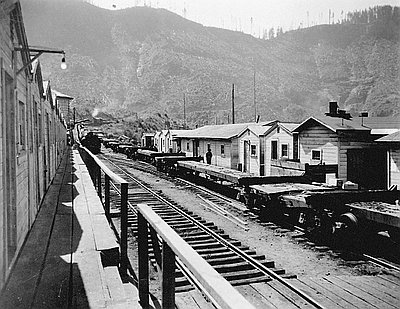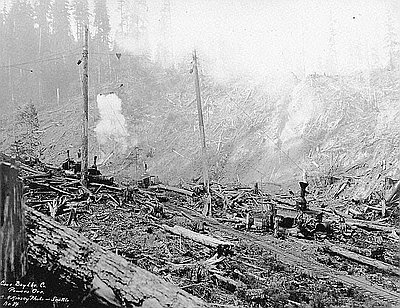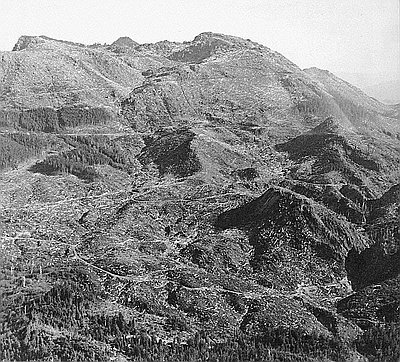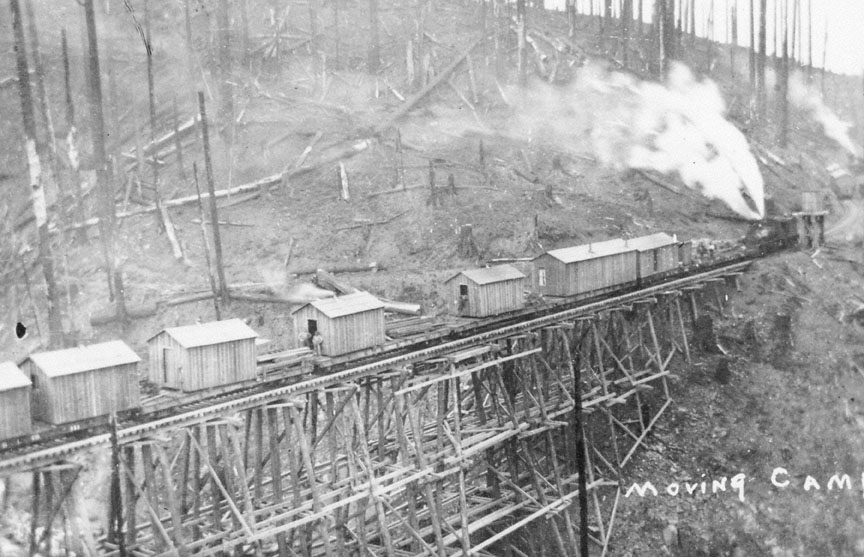- Catalog No. —
- OrHi 48497
- Date —
- c. 1910s
- Era —
- 1881-1920 (Industrialization and Progressive Reform)
- Themes —
- Environment and Natural Resources, Transportation and Communication
- Credits —
- Oregon Historical Society
- Regions —
- Central
- Author —
- Unknown
Moving Camp
This undated, anonymous photograph of two trains transporting a mobile camp across an unidentified, recently burned-over, and partially logged forest could have been taken anywhere in the Pacific Northwest, most likely between 1910 and 1920. The camp buildings being transported in this photograph were lifted onto the flatbed cars and were not permanently attached to the rail “trucks” or undercarriages as some prefabricated camp cars were during the early twentieth century.
Beginning in the 1880s, railroads began to be utilized by logging companies eager to harvest trees in rugged backcountry areas. By then, much of the easily accessible timber located along waterways had already been claimed, cut, and sent to market.
Railroads provided logging companies with the means to more efficiently reach timber sites. Still, in order to maximize profits, many companies cut costs on the hardware needed to build short “spur lines” into the woods that branched off of main rail lines. Rails were usually acquired second or third-hand. The layout of the tracks was often—though not always—planned by a crew leader skilled with a compass and familiar with the terrain, rather than with the aid of a skilled engineer, making travel on the rails extremely dangerous. Moreover, since logging spurs outlived their usefulness rather quickly, they were pulled up and reused over and over again.
Although railroads were used to transport logging crews and their camps to and from logging “shows” from the start, it wasn’t until around 1910 that companies began using prefabricated camp cars that could easily be moved about as needed. Around the same time, worn out railcars from around the country also gained a new lease on life with logging crews who converted them into living quarters (usually bunk houses), recreation and mess halls, tool sheds and shops, supply stores, and offices.
Camp cars were often built—or rebuilt—with discarded materials and hardware, making living conditions less than desirable for many loggers. Living conditions didn’t begin to improve appreciably until during World War I, when a regional strike and general unrest gave company owners the impetus to raise morale by improving housing and encouraging families to live together in some camps.
Further Reading:
Rajala, Richard A. “The Evolution of West Coast Logging.” Legion Magazine 72, 1997: 36-38.
Labbe, John T., and Vernon Goe. Railroads in the Woods. Arlington, Wash., 1995.
Robertson, Donald B. Encyclopedia of Western Railroad History. Vol. 3. Oregon and Washington. Caldwell, Idaho, 1995.
Burkhardt, D. C. Jesse.Backwoods Railroads: Branchlines and Shortlines of
Western Oregon. Pullman, Wash., 1994.
Written by Joshua Binus, © Oregon Historical Society, 2003.
Related Historical Records
-
Camp Two, Coos Bay Lumber Company
A moving community of loggers is depicted in this 1930 photograph. From the 1890s through World War II, major logging operations in Oregon were railroad-based, with trackage extending …

-
Coos Bay Lumber Company Steam Donkeys
The steam donkey, invented in 1880, greatly increased the efficiency of logging operations in Oregon’s forests. It replaced animal labor, which could not work as fast in rainy …

-
Logged-off Land near Neahkahnie Mountain, 1968
Al Monner took this 1968 photograph of clear-cut logging near Neahkahnie Mountain, located in northwest Tillamook County. Monner, who died in 1998, was a photographer for the Oregon …

